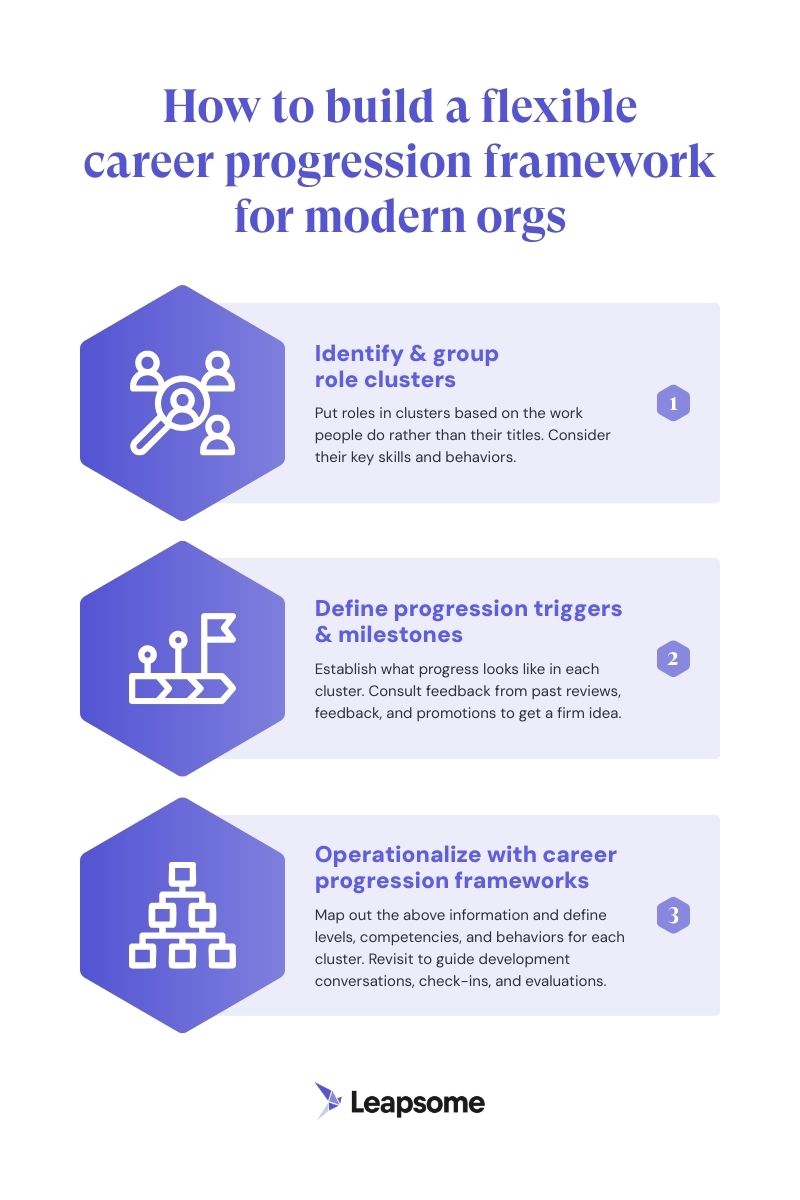Career progression frameworks: a modern guide

Most career progression frameworks are built for large companies with rigid hierarchies. But that structure doesn’t fit how many modern teams operate, especially SMBs and flatter organizations where impact matters more than job titles.
The opportunity is clear: build a flexible, skill-based framework that fits how your team actually works. You don’t need a full HR ops function or a polished leveling matrix. You need a system that shows people what growth looks like and helps managers talk about it consistently.
And it’s worth doing. LinkedIn’s Workplace Learning Report found that career growth is the number one reason employees stay at a company.*
This guide covers what modern career progression looks like, how to use skill stacking and dual-lane models, a step-by-step approach to designing your own framework, and real answers to potential objections you’ll hear along the way, so let’s get going.
🤔 Need help with your org’s career progression frameworks?
Our free, downloadable template can help you create meaningful development paths for your people.
👉 Download it now
*LinkedIn Workplace Learning Report, 2025
What career progression looks like in today’s organizations
Career progression today looks less like a ladder and more like a web. Modern organizations are shifting away from strict hierarchies and standardized titles, and businesses, both small and large, now embrace flatter structures, title fluidity, and cross-functional roles.
Progression isn't about climbing toward a new title every 18 months. Rather, it relates to people increasing their impact and expanding the breadth of their skills. This is just part of the reason why employees with diverse skills are 47% more likely to be hired and 33% more likely to be promoted than those with more limited skill sets.
However, these structures can create clarity issues. Just because a company is flat doesn’t mean it should be ambiguous. Employees still need to know how to grow, how they're evaluated, and what success looks like at all levels. Without that, the promise of flexibility can turn into a dead end.
As Lin Grensing-Pophal notes in HR Daily Advisor: “In flatter organizations, career growth looks different, but the need for it hasn’t gone away. Ambitious employees still want to advance, even if the traditional ladder isn’t there.”
The bottom line? Career development in modern businesses has to be defined by contribution and capability, not status or seniority.
💡 Not sure how to talk to team members about their professional aspirations and goals? Get inspired with our comprehensive list of 35 example career development questions.
Stackable skills & dual-lane career progression models

Modern career progression frameworks are shifting from rigid ladders to more flexible, stackable models. Career stacking means building depth across three dimensions: experience, influence, and capabilities. That means employees aren’t just climbing vertically; they’re expanding their range. For example, someone in marketing might take on a customer research project or dive into CRM automation. Those lateral moves aren’t detours. They add critical layers to their stack, increasing their impact without requiring a title change. Plus, they’ve been associated with higher compensation growth, as reported by Cornell University.
The dual-lane progression model supports this. It offers two distinct tracks: one for people who want to lead teams, and another for those who want to deepen their expertise without managing others. You can grow as a principal engineer or a senior individual contributor in customer success just as much as a VP or director.
This positively impacts organizations at all levels; in fact, according to CareerInisider, dual career ladders have been found to increase employee satisfaction, reduce turnover, and foster innovation.
👏 Spotify uses a dual-track promotion plan to ensure employees feel aligned, engaged, and motivated in their roles. This strategy is also becoming popular in other scaleups and agencies as it allows companies to invest in employee development and keep talent growing even if the org chart isn’t.
How to build a flexible career progression framework for modern orgs
Most advice on career progression assumes you’ve got a full HR ops team, a decent budget, and a traditional hierarchy. But if you're working in a flatter organization where people care more about growth than job titles, you need a development framework that’s lighter, more dynamic, and built for how your team actually operates.
Plus, setting one up is essential, as 44% of HR leaders believe their organizations lack compelling career paths.

1. Identify & group role clusters
First, group roles into clusters based on the kind of work they do, not their titles. For example:
- Operations
- Product
- Engineering
- Customer success
This lets you create shared progression paths without getting stuck writing a bespoke ladder for every job.
Next, keep the focus on skills and behaviors. What does good look like in each cluster? What does growth look like? Don’t aim for textbook perfection. Use the data you already have to help make your decisions, for example, manager input, past performance reviews, and calibration sessions. Capture the roles as they exist now, not as some theoretical future organization.
💜 Need help getting started with your career progression framework? Download our free competency framework template to get you inspired and help you organize your thoughts.
2. Define progression triggers & milestones
Next, outline what signals progression in your organization. Triggers could be things like being responsible for a broader scope of work, coaching peers, leading team trainings, or taking on cross-functional work. Milestones should be observable and role-relevant — things managers can point to in a feedback conversation and say, “you’re operating at the next level.”
This step doesn’t need to be a formal performance rubric. Just define what impact looks like as someone levels up in your company. Pull real examples from past 360° reviews, project retrospectives, or past promotions to make it concrete.
3. Operationalize with career progression frameworks
.jpeg)
Now, make all the above information actionable and usable. Create a lightweight competency framework for each cluster — one that shows the levels, the competencies, and the behaviors associated with each.
Then, equip managers with the tools they need: conversation prompts, questions for 1:1s, and a continuous performance management system that combines informal feedback with formal evaluations. Encourage team members to revisit their competency framework during development conversations and performance assessments.
Remember: The goal isn’t to systematize everything — it’s to give teams a shared language around growth.
🤓 Leapsome AI can help you get more done with less
Want to build competency frameworks but don’t have time for any extra admin? Our built-in AI tools can help you create them in minutes.
👉 Explore Leapsome AI
⭐ Bonus mini case study: a 50-person company’s framework in action
At a 50-person B2B SaaS company, the People lead and a few senior managers built a flexible career progression framework with a minimal HR and L&D budget. They grouped roles into three clusters — product, GTM (go-to-market), and engineering — and mapped shared skills and areas of impact, not job titles.
They used a dual-track model: one path for individual contributors focused on depth and expertise, and another for managers focused on leadership and strategy. Both were valued equally in status and compensation.
Each cluster got a clear competency framework that outlined levels, competencies, and behavior signals. Promotions were based on peer-reviewed evidence like retrospectives, continuous feedback, and 360°s. Managers used the frameworks for 1:1s to guide growth conversations and prep for biannual formal reviews.
Within a year, the company saw sharper feedback loops, more clarity around growth, and lower mid-level attrition. The framework became a common language across teams — with nothing more than a competency framework and a few committed champions.
Common objections & FAQ about career progression frameworks
When you're trying to introduce career path frameworks within your organization, you're bound to get pushback from leadership and team leads. Here’s an idea of how you can respond to common concerns while advocating for the value of consistent development plans.
Common objection #1: “our org is too fluid for fixed frameworks”
That’s actually a reason to have a framework — not a reason to avoid one. You don’t need rigid ladders, especially not when we incorporate stackable skills and dual-lane career progression models.
Let’s build something modular that tracks skills and behaviors instead of job titles, then review it quarterly so it stays flexible. Think of it more like a living system than a set of rules carved in stone.
Common objection #2: “it’s too much work for our small People team”
We won’t roll out career progression frameworks organization-wide on day one. We could pick one team — ideally one with a manager who’s already familiar with the process — and start there.
We can also get creative with our resources. Lots of competency framework solutions leverage AI to help create detailed matrices in a matter of minutes, or we could tweak existing performance review templates.
Once we come up with a first version that’s working well with the test group, we’ll be able to optimize it and make it into something scalable and repeatable. No need to over-engineer upfront.
Common objection #3: “won’t this confuse people without standard titles?”
People will only get confused if you make growth and internal mobility all about titles and a formal career ladder. The better, more sustainable move is to map growth to what people actually do — things like leading projects, mentoring others, and owning outcomes. Titles can stay fluid if the underlying expectations and progression signals are clear with tools like career progression frameworks.
Common objection #4: “we can’t afford formal L&D programs”
That’s a fair point — formal programs can get expensive fast. But that’s not the only option. You can get a lot of traction with peer mentorship, internal career development talks, and project-based growth goals. Plus, there are affordable learning and development tools out there that allow you to build your own courses without breaking the bank.
The point isn’t to build a corporate university. It’s to make development feel relevant, useful, and trackable, even without a big budget.
Guide career growth with Leapsome Competency Frameworks
.png)
Career progression doesn’t need to be tied to titles, tenure, or traditional ladders. Modern organizations need modern frameworks that reflect how people actually grow — by gaining skills, expanding work scope, and increasing their impact. Whether you’re running a 50-person team or scaling toward 500, a flexible, skill-based approach can help you bring clarity to growth, even in flatter, fast-moving environments.
Leapsome Competency Frameworks give you a simple, visual way to define and guide progression across all organizational levels. You can map dual-lane tracks, stackable skills, and growth behaviors in a format that’s easy to refer back to in 1:1s, calibrations, and performance reviews.
Start small — pilot your framework with one team, collect feedback on what really signals growth in your company and iterate from there. Career progression frameworks should be living systems, not static org charts.
And with the right structure, you’ll make it easier for managers to support development and for employees to see a future at your company.
🧠 Give employees the development they want
Build a continuous performance management system centered on career progression frameworks with Leapsome.
👉 Book a demo
Related articles
Back to the blogReady to transform
your People operations?
Automate, connect, and simplify all HR processes across the employee lifecycle.
.webp)
.webp)
 Request a demo today
Request a demo today






























